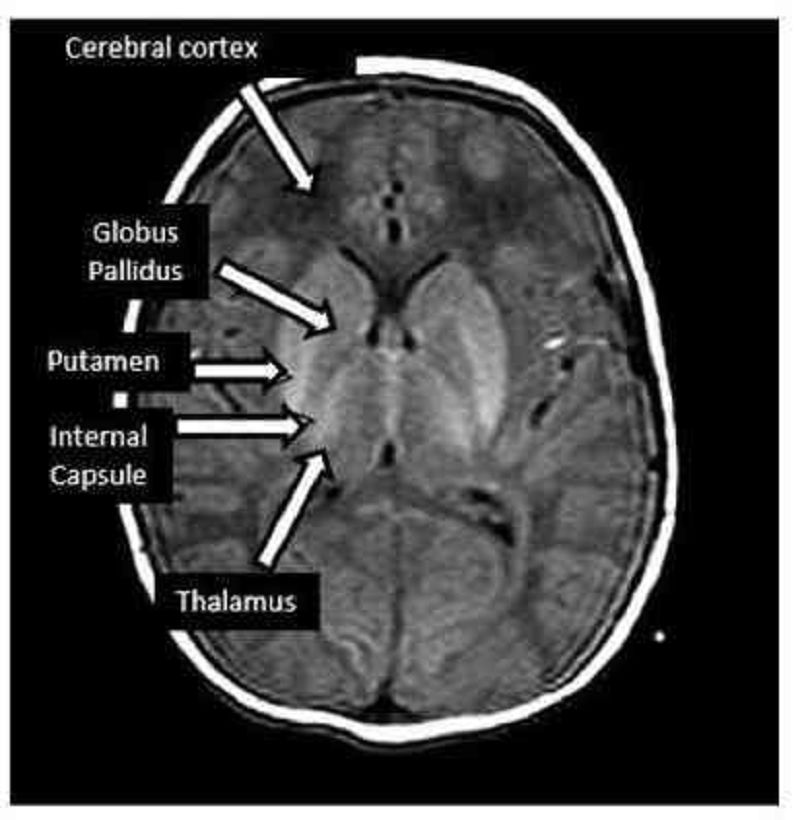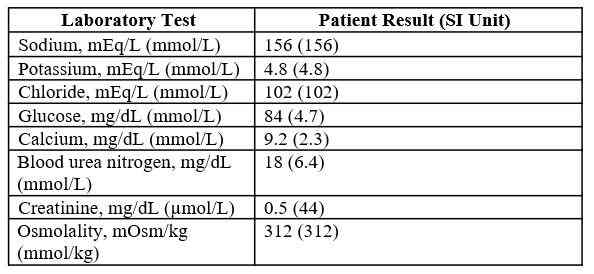NeoPrep- 9-8-2022

Neonatal Medicine Quiz
Test your knowledge in neonatal medicine with this comprehensive quiz designed for medical students, residents, and healthcare professionals. Covering a range of topics related to neonatal care, including conditions, treatment protocols, and best practices, this quiz will challenge your understanding and help reinforce key concepts.
Features:
- 10 Multiple Choice Questions
- In-depth scenarios based on real-life cases
- Immediate feedback on your answers

A 5-day-old male infant born at 41 weeks’ gestation is recovering from hypoxic-ischemic encephalopathy. A magnetic resonance scan of his brain is obtained (Figure 1). Of the following, the finding on the scan MOST predictive of a severely abnormal neuromotor outcome involves the
Internal capsule
Cerebral white matter
Globus pallidus
Putamen
Thalamus
A 35-year-old black woman who is 5 feet (152 cm) tall and weighs 99 lbs (45 kg) becomes pregnant following stimulation of ovulation and artificial insemination. Six weeks after conception, ultrasonographic examination shows the fetal crown-rump length to be below the 10th percentile for 8 weeks’ postmenstrual age. Maternal blood pressure is 120/90 mm Hg, and her hemoglobin concentration is 12.4 g/dL (124 g/L). She admits to smoking about 1 cigarette per week and consuming a glass of wine with dinner 3 to 5 days per week. She had been taking no dietary or vitamin supplements. Chorionic villus sampling demonstrates normal fetal karyotype: 46,XY. Of the following, the first trimester fetal growth restriction for this fetus is MOST closely related to maternal:
Age
Blood pressure
Alcohol consumption
Anthropometrics
Race
An infant is delivered by cesarean section at 37 weeks’ gestation to a 19-year-old primiparous woman with primary genital herpes simplex infection (HSV). She has been treated with acyclovir for the last 6 days. Active genital lesions suggestive of HSV are present on physical examination, and membranes spontaneously ruptured 2 hours before the delivery. The infant is active after delivery and has normal physical examination findings. Of the following, the MOST appropriate next step in the care of this infant is to:
Administer IVIG
Perform nasopharyngeal and other surface cultures
Isolate infant from mother
Treat with antiviral
Use formula instead of BM
A 6-week-old female infant, who weighed 2,140 g at birth at an estimated gestational age of 34 weeks, is being evaluated for fluid-electrolyte imbalance. She has had primary closure of gastroschisis at 1 week of age. Enteral feeds have been delayed because of feeding intolerance, which has led to exclusive parenteral nutrition through a central venous catheter. Her mean fluid intake is approximately 150 mL/kg per day. For the last 2 days, the infant has been receiving amphotericin B treatment for a positive blood culture for Candida albicans. She is observed to have numerous wet diapers. Physical examination of the infant reveals a slightly sunken fontanel and loss of skin turgor. She has no apparent malformations or dysmorphic features. Neurologic examination reveals normal tone, activity, and reflexes. The infant is breathing spontaneously in room air without distress and has no signs of cardiac dysfunction. Abdominal examination finds no hepatosplenomegaly or masses. Cranial and renal ultrasonographic studies are normal.
Serum chemistry reveals the following-

The infant's mean urine output is 9.6 ml/kg/hr in the last 24 hours. Other urine measurements are as follows:
Specific gravity 1.002; Osmolality 254 mOsm/kg and sodium 28 mEq/L
Urine is negative for protein, glucose or bacteria.
Of the following, the diabetes insipidus suspected in this infant is most likely to be-
Dipsogenic polyuric
Primary Nephrogenic
Primary neurogenic
Secondary Neurogenic
Secondary Nephrogenic
A 1,500-g male infant born at 32 weeks’ gestation is brought to your nursery with respiratory distress. A blood gas analysis shows a carboxyhemoglobin concentration of 5%. After you attend to the child, you talk with the obstetrician and find that the mother is a 19-year-old primigravida cigarette smoker. You go to see the mother in her hospital room to talk to her and her family. The maternal grandmother is an epidemiologist. She engages you in a discussion about the risks to the child, from exposure to smoking during the mother’s pregnancy and later to secondhand smoke. Of the following, secondhand smoke exposure in childhood, compared with smoking in pregnancy, is MOST clearly associated with:
Adolescent Tobacco use
Childhood cancer
Obesity
Hyperactivity
Wheezing illness
A 3,060-g male infant is born at 36 weeks’ gestation following a pregnancy complicated by gestational diabetes. He is noted to have asymmetric crying facies and dysmorphic facial features (Figures 1 and 2). A cardiac murmur is auscultated and a chest radiograph is obtained (Figure 3). An epibulbar dermoid is noted on examination of the right eye. Of the following, the MOST likely diagnosis for this infant is

Branchio-oto-renal syndrome
Hemifacial Microsomia
Marshall syndrome
Goldenhaar syndrome
Townes-Brocks Syndrome
The chief of pediatrics would like to improve the neonatology training of the pediatric residents in her program. She asks you to develop a new curriculum for the pediatric residents in the neonatal intensive care unit. Of the following, the MOST important first step in developing this curriculum is to:
Define the learning goals of the curriculum
Describe the learning objectives of the curriculum
Identify the hidden curriculum
Select specific educational strategies
Perform a needs assessment
An 800-g male infant was born at 26 weeks’ gestation via cesarean delivery because of maternal abruptio placentae. He had signs of respiratory distress immediately and was treated with endotracheal surfactant and assisted with positive pressure ventilation. He was fed initially with parenteral nutrition via a central venous catheter plus small feedings of expressed breast milk. Parenteral nutrition was weaned gradually as enteric intake was increased. Early on the seventh day, he began to have increasing gastric residuals. He later developed abdominal distention. An abdominal radiograph revealed a small area of pneumatosis intestinalis and no free air. Perfusion was good; blood pH and bicarbonate were normal. Enteric feedings were stopped, antibiotics initiated, and intravenous feedings ordered with the intention to provide adequate calories for maintenance and growth. He received a solution containing 3.5 g/100 mL of amino acids, 15% glucose, and appropriate electrolytes, minerals, and multivitamins infused at a rate of 3.7 mL/hour. In addition, he received a 20% lipid solution infused at a rate of 0.3 mL/hour. Of the following, the CLOSEST estimate of the number of kilocalories (kilojoules) being delivered per kilogram of body weight per day is:
120 (28.7)
90 (21.5)
110 (26.3)
100 (23.9)
80 (19.1)
As a member of your hospital’s institutional review board (IRB), you listen while your partner presents his randomized trial to evaluate the efficacy of a silver impregnated endotracheal tube to the committee. You are the only neonatologist on the committee and will serve as a coinvestigator for his trial. Your partner designed the endotracheal tube and holds 10% equity in the family company. His wife has a 5% stake in the company and his brother-in-law holds 85% equity in the company. Your partner informs the committee that he will obtain parental consent for the trial. As he finishes his presentation, you consider how best to manage potential conflicts of interest in the research. Of the following, the BEST means to manage conflict of interest is to:
Be present at the IRB deliberations of the protocol
Disclose the amount of your partner’s equity in the company on the consent form
Exclude your partner as an investigator in the trial
Disclose the brother-in-law’s stake in the company
Have the attending physician on service obtain consent rather than your partner
A 4-day-old male infant born at 41 weeks’ gestation is readmitted with tonic-clonic seizures that are difficult to control, hiccups, and hypotonia. Despite phenobarbital and phenytoin treatment, overt seizures are occurring every 15 to 30 minutes. Hiccups occur frequently, and several self-resolved apnea episodes also have been observed. Electroencephalography revealed status epilepticus and a background burst-suppression pattern. Hiccups were noticed beginning on the first day after birth and the seizures were first noticed at 2 days of age. The infant’s mother is an 18-year-old primigravida. Although the prenatal course had been uncomplicated, an increase in fetal movement frequency was noticed in the week before birth. Furthermore, fetal movements were reported to be “jerky,” erratic, a few minutes in duration, and recurring several times an hour. Laboratory studies, blood and cerebral spinal fluid cultures (for bacteria, fungi, and viruses), and cerebrospinal fluid polymerase chain reaction for herpes virus have been normal for age. No acidosis or ketosis has been detected. The serum ammonia, lactate, and pyruvate concentrations are normal. Magnetic resonance imaging of the brain revealed mild thinning of the corpus callosum. Urine and plasma specimens have been sent for organic acid and amino acid screening. Of the following, the compound responsible for the disorder in this infant MOST likely is:
Methylmalonic acid
Leucine
Phenylalanine
Glycine
Pyridoxine
{"name":"NeoPrep- 9-8-2022", "url":"https://www.quiz-maker.com/QPREVIEW","txt":"Test your knowledge in neonatal medicine with this comprehensive quiz designed for medical students, residents, and healthcare professionals. Covering a range of topics related to neonatal care, including conditions, treatment protocols, and best practices, this quiz will challenge your understanding and help reinforce key concepts.Features:10 Multiple Choice QuestionsIn-depth scenarios based on real-life casesImmediate feedback on your answers","img":"https:/images/course1.png"}
More Quizzes
USLME_BASIC
22110
Epinephrine Quiz
10531
Movie Villains
15819
Sustainability Week
17833
Nervous System - Test Your Anatomy Knowledge
201018462
Ultimate Soap Opera - Test Your Knowledge
201018237
Is My Cat Autistic? Free to Check the Signs
201016847
Tinikling Bamboo Size - How Long Are the Sticks?
201016730
AFI 11-401 Aviation Resource Management - Free
201022548
Thigh Muscle - Free Anatomy Practice
201017671
Group Compatibility Test - Find Your Ideal Friend Squad
201016502
Free NCBTMB Practice Test - Massage Therapy Exam Prep
201020187